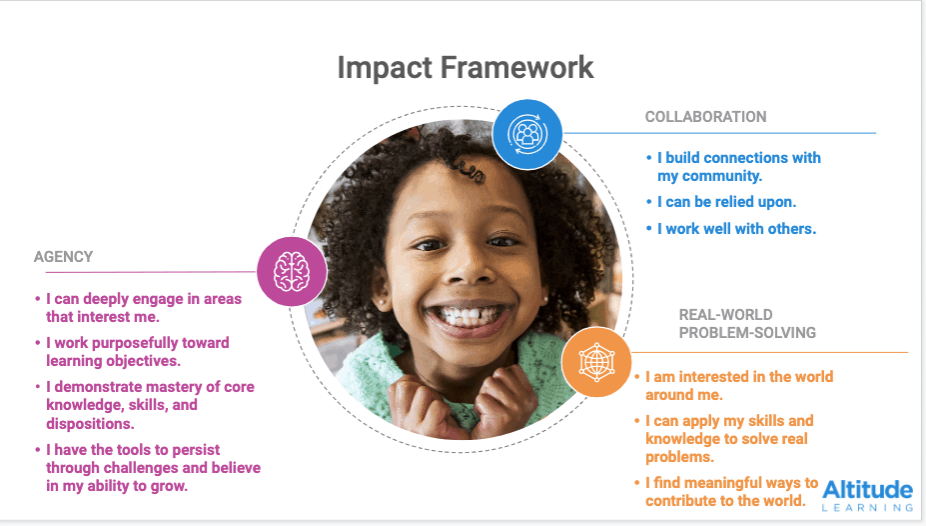Supporting Statewide Change Through New Models For Remote Education

CARES Act funding encourages states to create new, field-initiated models for providing remote education not yet imagined, to ensure that every child is learning and preparing for successful careers and lives. In many places, the pandemic has exposed the limitations of remote education. This federal priority challenges us to not settle for the remote learning models we know today, or to give up on remote learning altogether, waiting out the crisis to return to the flawed but familiar system we knew before. It charges us instead, to draw on our collective creativity, and seize the moment to introduce entirely new models for learning that are capable of achieving the equity and outcomes our modern world demands.
New Models: Not Widely Adopted, Not Yet Imagined
This is an explicit call for innovation, and a unique opportunity to reimagine education. So where should you start? We believe that the place to start is with the learner. As you begin to build out your logic model for change, keep the learner at the center and identify key competencies learners need to thrive – try removing the frames you have placed on grade and content outcomes and consider the roles of dispositions, skills and cross-content experiences.
Start with the Learner
Schooling models should be, above all, learner-centered. This means providing experiences that are personalized, relevant, and contextualized, socially embedded, competency-based, open-walled, and characterized by high levels of learner agency. Achieving this vision requires understanding the needs and aspirations of families and communities in a new way.
Design with the end in mind
Constructing a competency-based system for your community will require creativity and malleability to your approach to teaching and learning. This priority seeks to address unique unmet needs within your state. What gaps might you tackle through this work? What models show promise and how might you take them to scale?
New models should have updated outcome frameworks
Traditional outcome measures will beget traditional design features. New models require new thinking about the outcomes they are trying to achieve and these outcomes in turn influence program design.
Know the risks
Envisioning new models for learning is exciting. But poorly designed or shoddily implemented, they risk worsening some of the most troubling elements of the system students and families have experienced over the past four months (or past four decades). Most obvious and important is the risk of widening existing gaps in access and outcomes.
Avoid going “back to basics”
It may be tempting when shifting to a remote paradigm to “get the basics right first”, then move to more authentic learning. We encourage leaders to avoid this kind of thinking. From the beginning, adopt or develop an impact framework aligned with the new, learner-system we want to create, and design accordingly. Otherwise, we will undertake tremendous effort to simply recreate a new version of the teaching and learning process we already know.
Don’t equate screen time and remote learning
This is an opportunity to think creatively about what school looks like. Open-walled, community embedded, student-driven learning does not equate to seat or screen time. There are many different ways to leverage technology to facilitate rich, authentic learning, and to make the school experience mobile. In the same way we want to move beyond traditional “sit and get” learning in-person, we need to do so with our remote models. Consider how students can choose to engage, problem-solve, and steer their learning time off the screen.
Getting the logic model right
Leaders should build out a values-driven logic model for their reimagined systems. Components of this work may include strategies, activities, processes, products, or practices. This priority may be leveraged to scale ongoing work, so leaders should both consider active in-state innovation as well as new areas to innovate. Here are four specific features worth incorporating into your SEA theory of change.
Diversity and inclusion
When we envision online learning we often bring along our own lived experiences. We need to identify ways of fully integrating the range of households learners live in, and the full range of learners our systems serve. As we consider new, remote models, consider how to best use mobile technology, support families that may be experiencing trauma, support students with special education needs, and provide access to all families.
User-centered design
The best way to ensure that new models are designed for diversity and inclusion is to deeply engage and understand the needs and experiences of users throughout the design process. This is about direct engagement with the end-users to understand their needs and design aligned solutions. It is more akin to design processes employed in technology industries than traditional public engagement practices, often employing research and data analysis to understand the behavior of users and respond to their actions. Engage with the most directly connected stakeholders to understand their pain points, hopes, and current challenges. Use this information to build out personas, use cases, and appropriate analytics. In addition to learners and families, include educators here, leveraging information gained to create and incorporate effective adult learning from day 1, another important piece of delivering a successful solution.
Knots and ladders
Some learning is linear. This learning, like a ladder, follows a clear progression of steps that naturally follow each other. This kind of learning, such as multiplication or division, is conducive to certain learning technologies such as cognitive tutors and other adaptive learning technologies scaffold students effectively from one component of the skill to the next.
Other learning is messy. There is more than one way to solve a problem. No right or wrong answers, interdisciplinary elements. This kind of learning is much more similar to the kind of learning the modern workplace demands. But it is much more difficult to measure outcomes, or teach through traditional software solutions. New remote models must incorporate both of these types of learning, technologies capable of supporting each, and impact frameworks that value both. Consider how you can build out components of your logic model to include both types of learning and how you might support your educators in guiding this type of approach.
Scheduling and logistics
Leverage technology not only to deliver diverse types of learning but to break free of traditional constraints of the “master schedule”. New models of remote learning have the opportunity to connect the teacher, learner, parent, learning space, other community assets in much more sophisticated ways than the traditional academic schedule. Learning can be chunked and made mobile in exciting ways.
Operationalizing This Strategy
The above points seek to clarify the vision for what a successful locally sourced or field-initiated model might look like, how to avoid getting it wrong, and what needs to be included in order to get it right. But how should SEAs approach implementation? How should they be thinking about the process of delivering this kind of system on an extremely rapid timeline?
About the Moving Forward Together coalition
The Moving Forward Together coalition coalesced around the opportunity to build an agile coalition to support SEAs in responding to the current crisis in a way that helps SEAs create a better, more learner-centered system. Anchoring this coalition are:
- Altitude Learning provides learner-centered technology solutions to support competency-based, personalized, and authentic learning both through LEAs and direct to families through Altitude Learning @Home. Leaders in learner-centered technology and practice, Altitude’s staff literally wrote the books on Learner Centered Leadership and Learner Centered Innovation.
- Getting Smart is a prolific thought leader in learning innovation uniquely situated to help LEAs establish an approach for innovating in their state’s context. Getting Smart provides a variety of key implementation supports from program design to communications.
The coalition is led by Devin Vodicka, Chief Impact Officer at Altitude and former CA Superintendent of the Year, and Tom Vander Ark, CEO at Getting Smart, former Superintendent in WA State, and the first Executive Director of Education for the Bill & Melinda Gates Foundation.
Other “Moving Forward Together” partners will be pulled in as needed to bring their unique expertise to bear supporting SEA plans. They include: Digital Promise, NGLC, Education Reimagined, KnowledgeWorks, former superintendents, content and assessment experts, and workforce and higher education consultants.
Unique capabilities
Due to the diversity, depth, and breadth of coalition partners, the Moving Forward Together coalition can help pursue a locally sourced approach to redefining remote learning. Specifically, the coalition can provide: Input and advice; Strategy and implementation; Technology; Design; and Talent development.
In addition to bringing lessons from successes and failures from the leading edge of innovation, coalition leaders understand the constraints and pressures facing SEAs and LEAs. Implementing a field-initiated remote learning model will require significant attention to:
- Meeting state and federal requirements that still apply to this learning ecosystem;
- Bringing together a diverse coalition of experts and service providers; and
- Doing all of this at a lower cost than high-end consulting firms typically charge.
Another key consideration will be identifying research or local data supporting your components.
The Moving Forward coalition formed to bring together and apply the best thinking and learning from the field in a way that accounts for compliance-related constraints provides a convenient, one-stop-shop for SEA leaders, and delivers these services at a competitive rate while engaging experienced practitioners.
For more, see:
- Supporting Statewide Change Through Virtual Course Access Models
- Supporting Statewide Change Through Microgrants to Families
Stay in-the-know with innovations in learning by signing up for the weekly Smart Update.






0 Comments
Leave a Comment
Your email address will not be published. All fields are required.